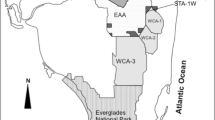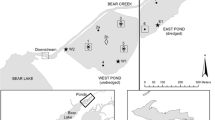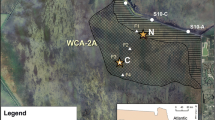Abstract
The response of wetlands to elevated nutrient loads typically has been examined in the context of using wetlands for nutrient removal. However, concern over the degradation of natural wetlands following anthropogenic disturbance continues to increase. Most research has focussed on the response of emergent wetlands, with an emphasis on the role of macrophytes. In this study, 21 1.8 m2 enclosures (mesocosms) were placed in a pristine open-water (slough) wetland and subjected to 7 inorganic phosphorus (P) loads; 0, 0.4, 0.8, 1.6, 3.2, 6.4, and 12.8 g/m2/y. This study demonstrated that while the rate of specific P accumulation was a function of the loading rate, the duration of loading is a critical factor in the ultimate P concentration in the biota and soil. Thus, time is an important consideration when determining response to enrichment. Phosphorus added to the slough was removed rapidly by the initially abundant metaphyton (unattached floating and suspended periphyton) and epipelon (benthic periphyton), which concentrated P 10- to 50-fold above background periphyton concentrations. Metaphyton concentrated P more rapidly than epipelon; however, both assemblages stabilized P concentrations between 2.6–3.0 g/kg. Water lily responded to elevated P loads with increased leaf size and nutrient accumulation. After 2-y, water lily P concentrations in the highest loaded mesocosms were similar to those observed in periphyton. Soil and porewater nutrients were slower to respond to P enrichment. Soil P concentrations were unchanged by P enrichment except for the highest loaded mesocosms. After 1-y of P loading, mesocosms receiving 12.8 g/m2/y had soil P concentrations almost 2-fold higher than background concentrations. Porewater P concentrations also showed little change throughout the experiment, with the exception of load 12.8 g/m2/y, which increased dramatically after the 1st year. During the 2nd year, average porewater P concentrations in this highest load were over 50-fold higher than background concentrations. Nitrogen concentrations in periphyton and water lily also generally increased in response to increased P loads. The high affinity of periphyton and water lily for P, combined with their subsequent influence on N uptake, suggests that these components can play an important role in wetland nutrient cycling. The disappearance of these communities may result in a reduction in the nutrient assimilative capacity of wetlands.
Similar content being viewed by others
References
Bechtel T., Hill S., Iricanin N., Jacobs K., Mo C., Mullen V. et al. 1999. Status of compliance with water quality criteria in the Everglades protection area and tributary waters. Chapter 4 Everglades Interim Report. South Florida Water Management District, West Palm Beach, Florida, USA.
Belanger T.V., Scheidt D.J. and Platko J.R. 1989. Effects of nutrient enrichment on the Florida Everglades. Journal of Lake and Reservoir Management 5: 101–111.
Browder J.A., Cottrell D., Brown M., Newman M., Edwards R., Yuska J. et al. 1982. Biomass and Primary Production of Microphytes and Macrophytes in Periphyton Habitats of the Southern Everglades (T-662). South Florida Research Center, Homesresponses synoptictead, Florida, USA.
Craft C.B., Vymazal J. and Richardson C.J. 1995. Response of Everglades plant communities to nitrogen and phosphorus additions. Wetlands 15: 258–271.
Cronk J.K. and Mitsch W.J. 1994. Periphyton productivity on artificial and natural surfaces in constructed freshwater wetlands Ecounder different hydrologic regimes. Aquatic Botany 48: 325–341.
Davis S.M. 1994. Phosphorus inputs and vegetation sensitivity in the Everglades. In: Davis S.M. and Ogden J.C. (eds), Everglades: The Ecosystem and its Restoration. St. Lucie Press, Delray Beach, Florida, USA, pp. 357–378.
Davis S.M., Gunderson L.H., Park W.A., Richardson J.R. and Mattson J.E. 1994. Landscape dimension, composition, and function in a changing Everglades ecosystem. In: Davis S.M. and Ogden J.C. (eds), Everglades: The Ecosystem and its Restoration. St. Lucie Press, Delray Beach, Florida, USA, pp. 419–444.
Denny P. 1987. Mineral cycling by wetland plants-a review. Archiv ¨ fur Hydrobiologie Beiheit Ergenbissen der Limnologie 27: 1–25.
Faulkner S.P., Patrick W.H. Jr and Gambrell R.P. 1989. Field techniques for measuring wetland soil parameters. Soil Science Society of America Journal 53: 883–890.
Flora M.D., Walker D.R., Burgess D.R., Scheidt D.J. and Rice R.G. 1986. The response of experimental channels in Everglades National Park to increased nitrogen and phosphorus loading.Water Resources Report No. 86-6. National Park Service,Water Resources Division, Colorado State University, Fort Collins, Colorado, USA.
Goldsborough L.G. and Robinson G.G.C. 1985. Effect of an aquatic herbicide on sediment nutrient flux in a freshwater marsh. Hydrobiologia 122: 121–128.
Goldsborough L.G. and Robinson G.G.C. 1996. Pattern in wetlands. In: Stevenson R.J., Bothwell M.L. and Lowe R.L. (eds), Algal Ecology: Freshwater Benthic Ecosystems. Academic Press, New York, New York, USA, pp. 77–117.
Grimshaw H.J., Rosen M., Swift D.R., Rodberg K. and Noel J.M. 1993. Marsh phosphorus concentrations, phosphorus content and species composition of Everglades periphyton communities. ¨ Archiv fur Hydrobiologie 128: 257–276.
Grimshaw H.J., Wetzel R.G., Brandeburg M., Segerblom M., Wenkert L.J., Marsh G.A. et al. 1997. Shading of periphyton communities by wetland emergent macrophytes: decoupling of Everalgal photosynthesis from microbial nutrient retention. Archiv ¨ fur Hydrobiologie 139: 17–27.
Hansson L.-A. 1989. The influence of a periphytic biolayer on ¨ phosphorus exchange between substrate and water. Archiv fur Hydrobiologie 115: 21–26.
Hesslein R.H. 1976. An in situ sampler for close interval porewater studies. Limnology and Oceanography 21: 912–914.
Howard-Williams C. and Allanson B.R. 1981. Phosphorus cycling in a dense Potamogeton pectinatus L. bed. Oecologia (Berl.) 49: 56–66.
Jensen J.R., Rutchey K., Koch M.S. and Narumalani S. 1995.Inland wetland change detection in the Everglades Water Conservation Area 2A using a time series of normalized remotely sensed data. Photogrammetric Engineering and Remote Sensing 61: 199–209.
Koerselman W. and Meuleman A.F.M. 1996. The vegetation N:P ratio: a new tool to detect the nature of nutrient limitation. Journal of Applied Ecology 33: 1441–1450.
McCormick P.V. and O'Dell M.B. 1996. Quantifying periphyton Homesresponses to phosphorus in the Florida Everglades: a synoptictead, experimental approach. Journal of the North American Benthological Society 15: 450–468.
McCormick P.V. and Scinto L.J. 1999. Influence of phosphorus loading on wetlands periphyton assemblages: a case study from the Everglades. In: Reddy K.R., O'Connor G.A. and Schelske C.L. (eds), Phosphorus biogeochemistry in Subtropical Ecounder systems. CRC/Lewis Publishers, Boca Raton, Florida, USA, pp. 301–319.
McCormick P.V., Rawlik P.S., Lurding K., Smith E.P. and Sklar F.H. 1996. Periphyton-water quality relationships along a nutrient gradient in the northern Everglades. Journal of the North American Benthological Society 15: 433–449.
McCormick P.V., Shuford R.B.E. III, Backus J.G. and Kennedy W.C. 1998. Spatial and seasonal patterns of periphyton biomass and productivity in the northern Everglades, Florida, U.S.A. Hydrobiologia 362: 185–208.
McCormick P.V., Newman S., Miao S.L., Gawlik D.E., Marley D., Reddy K.R. et al. 2001a. Effects of anthropogenic phosphorus inputs on the Everglades. In: Porter J.W. and Porter K.G. (eds), The Everglades, Florida Bay, and Coral Reefs of the Florida Keys: An Ecosystem Sourcebook. CRC Press, Boca Raton, Florida, USA, pp. 83–126.
McCormick P.V., O'Dell M.B., Shuford R.B.E.I., Backus J.G. and Kennedy W.C. 2001b. Periphyton responses to experimental phosphorus enrichment in a subtropical wetland. Aquatic Botany 71: 119–139.
Miao S.L. and Sklar F.H. 1998. Biomass and nutrient allocation of sawgrass and cattail along a nutrient gradient in the Florida Everglades. Wetlands Ecology and Management 5: 245–263.
Newman S., Schuette J., Grace J.B., Rutchey K., Fontaine T., Reddy K.R. et al. 1998. Factors influencing cattail abundance in the northern Everglades. Aquatic Botany 60: 265–280.
Newman S., Kumpf H., Laing J.A. and Kennedy W.C. 2001.Decomposition responses to phosphorus enrichment in an Everglades (USA) slough. Biogeochemistry 54: 229–250.
Reddy K.R., Kadlec R.H., Flaig E. and Gale P.M. 1999. Phosphorus retention in streams and wetlands: a review. Critical Reviews in Environmental Science and Technology 29: 1–64.
Richardson C.J., Cooper S.R., Qian S.S., Qualls R.G., Romanowicz E.A., Stevenson R.J. et al. 1997. Effects of phosphorus and hydroperiod alterations on ecosystem structure and function in the Everglades. Duke Wetland Center Publication 97-05. Everalgal glades Agricultural Area Environmental Protection District.
Rutchey K. and Vilchek L. 1994. Development of an Everglades vegetation map using a SPOT image and the global positioning system. Photogrammetric Engineering and Remote Sensing 60: 767–775.
SAS Institute Inc. 1996. SAS system for mixed models. Cary, North Carolina, USA.
SAS Institute Inc. 2000. SAS/STAT User's guide, Version 8. Cary, North Carolina, USA.
Sinden-Hempstead M. and Killingbeck K.T. 1996. Influences of water depth and substrate nitrogen on leaf surface area and maximum bed extension in Nymphaea odorata. Aquatic Botany 53: 151–162.
Swift D.R. and Nicholas R.B. 1987. Periphyton and water quality relationships in the EvergladesWater Conservation Areas 1978–1982. Technical Publication 87-2. South Florida Water Management District, West Palm Beach, Florida, USA.
Tsuchiya T. 1991. Leaf life span of floating-leaved plants.Vegetatio 97: 149–160.
Twilley R.R., Brinson M.M. and Davis G.J. 1977. Phosphorus absorption, translocation, and secretion in Nuphar luteum. Limnology and Oceanography 22: 1022–1032.
Urban N.H., Davis S.M. and Aumen N.G. 1993. Fluctuations in sawgrass and cattail densities in Everglades Water Conservation Area 2A under varying nutrient, hydrologic and fire regimes.Aquatic Botany 46: 203–223.
U.S. Environmental Protection Agency (USEPA) 1983. Methods for Chemical Analysis of Water and Wastes. USEPA, Cincinnati, Ohio, USA.
U.S. Environmental Protection Agency (USEPA) 1986. Test Methods for Evaluating Solid Waste, Physical and Chemical Methods. USEPA, Cincinnati, Ohio, USA.
Walker W.W. 1995. Design basis of Everglades Stormwater Treament Areas. Water Research Bulletin 31: 671–685.
Author information
Authors and Affiliations
Corresponding author
Rights and permissions
About this article
Cite this article
Newman, S., McCormick, P.V., Miao, S.L. et al. The effect of phosphorus enrichment on the nutrient status of a northern Everglades slough. Wetlands Ecology and Management 12, 63–79 (2004). https://doi.org/10.1023/B:WETL.0000021664.32137.dd
Issue Date:
DOI: https://doi.org/10.1023/B:WETL.0000021664.32137.dd




